Tuesday, October 31, 2006:
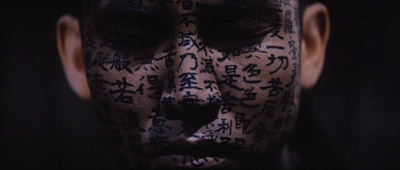
The Orb -- Ghostdancing
Neko Case -- Ghost Wiring
Kwaidan is a quartet of ghost stories directed by Masaki Kobayashi based on Lafcadio Hearn's adaptations of Japanese legends. Often classed a horror film, it's not especially horrifying: the stories are simple, the pacing deliberate, and for a gaijin audience the resolutions are predictable (whereas for a Japanese audience, there's less need for prediction: people in the audience unfamiliar with the legends would still know that the film's title means "ghost story").
In the first segment, "The Black Hair," a samurai leaves his devoted wife to marry a woman from a prestigious family, then realises both her selfishness and his own and returns to his first wife. In the second, "The Woman of the Snow," a woodcutter sees his companion killed by Yuki-onna, the spirit of winter; she spares him on the condition that he never tell anyone what he's seen. In the third, "Hoichi the Earless," a blind biwa player is approached by samurai ghosts and ordered to play for a long-dead audience. In the fourth and final segment, "In a Cup of Tea," a samurai finds that whenever he pours himself a bowl of water, it always reflects a man who isn't there.
Though the film fails to terrify, its pleasures lie elsewhere: Kobayashi gifts the stories with a painstaking visual sense, favoring bold composition:
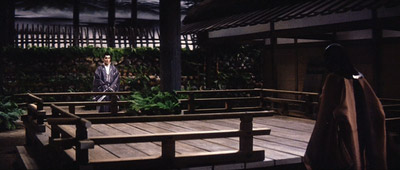
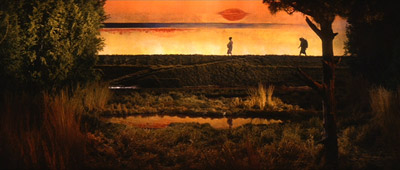
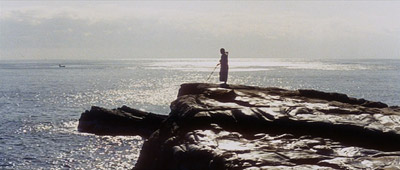
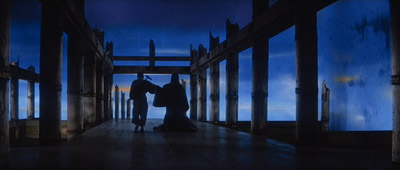
He films in the studio and uses blatant backdrops in outdoor scenes:

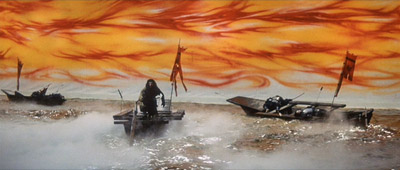
He makes use of theatrical lighting:
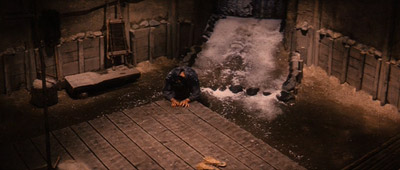

Colors are carefully controlled, often dominated by neutrals, and with only a few accents outside the dominant color scheme:
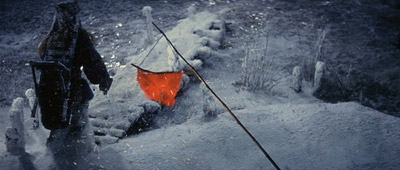
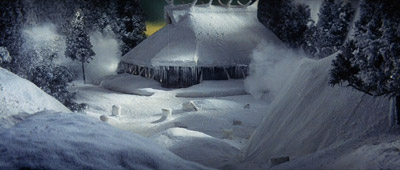
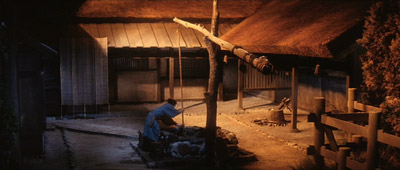
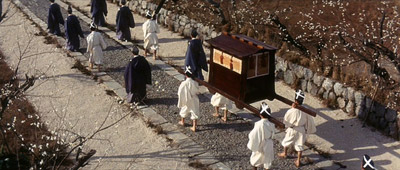
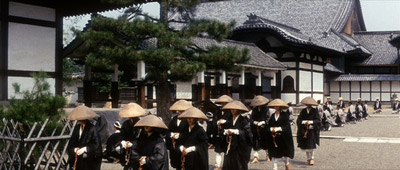
The Criterion Collection's essay on Kwaidan
[The Orb -- Cydonia]
[Neko Case -- Blacklisted]
The Orb, Neko again, Kwaidan

The Orb -- Ghostdancing
Neko Case -- Ghost Wiring
Kwaidan is a quartet of ghost stories directed by Masaki Kobayashi based on Lafcadio Hearn's adaptations of Japanese legends. Often classed a horror film, it's not especially horrifying: the stories are simple, the pacing deliberate, and for a gaijin audience the resolutions are predictable (whereas for a Japanese audience, there's less need for prediction: people in the audience unfamiliar with the legends would still know that the film's title means "ghost story").
In the first segment, "The Black Hair," a samurai leaves his devoted wife to marry a woman from a prestigious family, then realises both her selfishness and his own and returns to his first wife. In the second, "The Woman of the Snow," a woodcutter sees his companion killed by Yuki-onna, the spirit of winter; she spares him on the condition that he never tell anyone what he's seen. In the third, "Hoichi the Earless," a blind biwa player is approached by samurai ghosts and ordered to play for a long-dead audience. In the fourth and final segment, "In a Cup of Tea," a samurai finds that whenever he pours himself a bowl of water, it always reflects a man who isn't there.
Though the film fails to terrify, its pleasures lie elsewhere: Kobayashi gifts the stories with a painstaking visual sense, favoring bold composition:




He films in the studio and uses blatant backdrops in outdoor scenes:


He makes use of theatrical lighting:


Colors are carefully controlled, often dominated by neutrals, and with only a few accents outside the dominant color scheme:





The Criterion Collection's essay on Kwaidan
[The Orb -- Cydonia]
[Neko Case -- Blacklisted]
Labels: alt country, electronica, horror, movies
Monday, October 30, 2006:
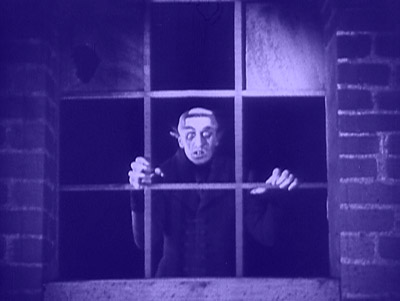
Lonnie Johnson -- No Love for Sale
Mississippi John Hurt -- Since I've Laid My Burden Down
(Spoiler warning: this post discusses plot elements of Bram Stoker's Dracula, F.W. Murnau's Nosferatu, Richard Matheson's I Am Legend, Whitley Strieber's The Hunger, and George A. Romero's Martin.)
The conductor's call goes out over a black screen; the scene opens on passengers boarding a train. The titles begin as the train approaches a crossing, warning lights flashing, bell dinging. Inside, a POV shot: walking down a hall, approaching a hand protruding past a curtain, palm up, its owner apparently asleep. The film cuts to Martin: tall, thin, pale; he eases past the hand looking frightened. In the restroom he opens a kit and prepares a syringe; in the hall he crouches to listen at a door, syringe gripped between his teeth. He picks the lock; the film cuts to a black and white shot of Martin opening a door, a woman in bed turning to him, arms outstretched. The film cuts back to color as Martin opens the cabin door; the bed is empty. The passenger can be heard in the restroom. Martin hides behind the restroom door, waiting for her. When she goes to her bed he rushes forward and stabs her with the syringe. They struggle; she is loud, terrified, enraged, pleading, curious: what did he inject her with? He tells her not to worry; he is always careful with the needles. She is not comforted with this knowledge. Eventually she passes out and he cuts her wrist with a blade and drinks her blood. When he's done he cleans up the cabin, leaving the razor and adding a bottle of spilled pills. The film is clearly a modern vampire story, yet director George Romero is not interested in indulging in the conventions of vampire fiction over the last century.
The classic vampire story, heavily influenced by Bram Stoker's novel Dracula, is set in an isolated, foreboding setting indicating centuries of unminded wealth and indifference to public opinion. The story is typically told from the point of view of the potential victims; the vampire can not enter a victim's home without permission; and the vampire has a curious hypnotic power over his victims--typically buxom women in nightgowns--as well as a weakness against garlic and crucifixes, to be finished off by sunlight or a stake to the heart. Bram Stoker wrote Dracula just before the turn of the 20th century; the film Nosferatu blatantly plagiarised the novel and was nearly lost as a result--Stoker's widow filed a suit charging copyright infringement, and the court ordered all copies of the film destroyed.
Without becoming distracted by all the stakes, it's safe to bring Freud into the conversation. The classic vampire story is about sexuality and repression, the id and the superego: the vampires can't enter a room without permission and so their victims have to allow their desire to cloud their judgment, arranging their own destruction. Jonathan Harker, in one of his nights in Dracula's castle, finds himself tempted by three of Dracula's women; he admits to his "repulsive" urges in his journal, though he notes that the admission would hurt Mina's feelings if she were to find it. And it's easy to imagine the passage in question loosening Victorian collars:
Since Stoker's and Murnau's work, some authors have expanded the scope of the myth. Richard Matheson in the 1950s and Whitley Strieber in the 1980s both explored vampirism as a disease, Matheson in an ominous futuristic backdrop with a sole human survivor and Strieber in an elegaic examination of love and loss in the face of weakened immortality. Anne Rice gave the genre her own distinctive treatment, starting in the 1970s, in a series of gothic novels largely concerned with ambience and glamour*.
Romero's treatment of the myth, just a year after Rice's Interview with the Vampire, is decidedly low-key. Martin is not wealthy; he is not powerful; he is not particularly intriguing or charismatic. The story is set in working-class Pittsburgh; Martin meets his uncle, Cuda, at the train station. Cuda walks Martin to his house, the walk filmed in a series of handheld shots, piano and flute on the soundtrack.
The general tone of the film is one of melancholy and longing, informed by skepticism and aware of preceding myth. Martin can't get people to do what he wants, he's not repelled by garlic or crucifixes; he doesn't sleep in a coffin on cemetery dirt. There's nothing seductive about Martin's process, nothing darkly attractive about the results. He finds the vampire stories exasperating, like the people who believe them, including his uncle.
The story comes across as a slice-of-life drama, perhaps because of the emphasis on relationships: Martin's antagonistic relationship with Cuda, his cautious relationship with Christina, with his slightly freer relationship with Mrs. Santini. In the broadest sense, the story is about a confused, unhappy young man who longs for human companionship yet has an overwhelming need preventing it. The treatment of the subject is surprisingly deft, light, and leavened with a gentle humor, as in the first scene at Cuda's home ("Vampire," Cuda says. "First I will save your soul. Then I will destroy you. I will show you your room.") And the conclusion, when it comes, is sudden, neat, and unexpectedly ironic, almost Hitchcockian in temperament, as if to imply that the particulars are insignificant since everyone is guilty of something.
*Rice's vampire books, for all their faults, are not as silly as Joel Schumacher's campy suburban horror film Lost Boys--which itself comes across looking like cinematic high art in comparison to Mel Brooks' execrable Dracula: Dead and Loving It. There are clever and interesting things that can be done with the vampire myth still; Brook successfully avoided all of them.
[Blues By Lonnie Johnson]
[The Immortal Mississippi John Hurt]
This post is part of the Vampires blogathon and will be updated with links to additional entries as they are published.
Martin / Nosferatu

Lonnie Johnson -- No Love for Sale
Mississippi John Hurt -- Since I've Laid My Burden Down
(Spoiler warning: this post discusses plot elements of Bram Stoker's Dracula, F.W. Murnau's Nosferatu, Richard Matheson's I Am Legend, Whitley Strieber's The Hunger, and George A. Romero's Martin.)
The conductor's call goes out over a black screen; the scene opens on passengers boarding a train. The titles begin as the train approaches a crossing, warning lights flashing, bell dinging. Inside, a POV shot: walking down a hall, approaching a hand protruding past a curtain, palm up, its owner apparently asleep. The film cuts to Martin: tall, thin, pale; he eases past the hand looking frightened. In the restroom he opens a kit and prepares a syringe; in the hall he crouches to listen at a door, syringe gripped between his teeth. He picks the lock; the film cuts to a black and white shot of Martin opening a door, a woman in bed turning to him, arms outstretched. The film cuts back to color as Martin opens the cabin door; the bed is empty. The passenger can be heard in the restroom. Martin hides behind the restroom door, waiting for her. When she goes to her bed he rushes forward and stabs her with the syringe. They struggle; she is loud, terrified, enraged, pleading, curious: what did he inject her with? He tells her not to worry; he is always careful with the needles. She is not comforted with this knowledge. Eventually she passes out and he cuts her wrist with a blade and drinks her blood. When he's done he cleans up the cabin, leaving the razor and adding a bottle of spilled pills. The film is clearly a modern vampire story, yet director George Romero is not interested in indulging in the conventions of vampire fiction over the last century.
The classic vampire story, heavily influenced by Bram Stoker's novel Dracula, is set in an isolated, foreboding setting indicating centuries of unminded wealth and indifference to public opinion. The story is typically told from the point of view of the potential victims; the vampire can not enter a victim's home without permission; and the vampire has a curious hypnotic power over his victims--typically buxom women in nightgowns--as well as a weakness against garlic and crucifixes, to be finished off by sunlight or a stake to the heart. Bram Stoker wrote Dracula just before the turn of the 20th century; the film Nosferatu blatantly plagiarised the novel and was nearly lost as a result--Stoker's widow filed a suit charging copyright infringement, and the court ordered all copies of the film destroyed.
Without becoming distracted by all the stakes, it's safe to bring Freud into the conversation. The classic vampire story is about sexuality and repression, the id and the superego: the vampires can't enter a room without permission and so their victims have to allow their desire to cloud their judgment, arranging their own destruction. Jonathan Harker, in one of his nights in Dracula's castle, finds himself tempted by three of Dracula's women; he admits to his "repulsive" urges in his journal, though he notes that the admission would hurt Mina's feelings if she were to find it. And it's easy to imagine the passage in question loosening Victorian collars:
I lay quiet, looking out from under my eyelashes in an agony of delightful anticipation. The fair girl advanced and bent over me till I could feel the movement of her breath upon me. Sweet it was in one sense, honey-sweet, and sent the same tingling through the nerves as her voice, but with a bitter underlying the sweet, a bitter offensiveness, as one smells in blood.
I was afraid to raise my eyelids, but looked out and saw perfectly under the lashes. The girl went on her knees, and bent over me, simply gloating. There was a deliberate voluptuousness which was both thrilling and repulsive, and as she arched her neck she actually licked her lips like an animal, till I could see in the moonlight the moisture shining on the scarlet lips and on the red tongue as it lapped the white sharp teeth.
Since Stoker's and Murnau's work, some authors have expanded the scope of the myth. Richard Matheson in the 1950s and Whitley Strieber in the 1980s both explored vampirism as a disease, Matheson in an ominous futuristic backdrop with a sole human survivor and Strieber in an elegaic examination of love and loss in the face of weakened immortality. Anne Rice gave the genre her own distinctive treatment, starting in the 1970s, in a series of gothic novels largely concerned with ambience and glamour*.
Romero's treatment of the myth, just a year after Rice's Interview with the Vampire, is decidedly low-key. Martin is not wealthy; he is not powerful; he is not particularly intriguing or charismatic. The story is set in working-class Pittsburgh; Martin meets his uncle, Cuda, at the train station. Cuda walks Martin to his house, the walk filmed in a series of handheld shots, piano and flute on the soundtrack.
The general tone of the film is one of melancholy and longing, informed by skepticism and aware of preceding myth. Martin can't get people to do what he wants, he's not repelled by garlic or crucifixes; he doesn't sleep in a coffin on cemetery dirt. There's nothing seductive about Martin's process, nothing darkly attractive about the results. He finds the vampire stories exasperating, like the people who believe them, including his uncle.
The story comes across as a slice-of-life drama, perhaps because of the emphasis on relationships: Martin's antagonistic relationship with Cuda, his cautious relationship with Christina, with his slightly freer relationship with Mrs. Santini. In the broadest sense, the story is about a confused, unhappy young man who longs for human companionship yet has an overwhelming need preventing it. The treatment of the subject is surprisingly deft, light, and leavened with a gentle humor, as in the first scene at Cuda's home ("Vampire," Cuda says. "First I will save your soul. Then I will destroy you. I will show you your room.") And the conclusion, when it comes, is sudden, neat, and unexpectedly ironic, almost Hitchcockian in temperament, as if to imply that the particulars are insignificant since everyone is guilty of something.
*Rice's vampire books, for all their faults, are not as silly as Joel Schumacher's campy suburban horror film Lost Boys--which itself comes across looking like cinematic high art in comparison to Mel Brooks' execrable Dracula: Dead and Loving It. There are clever and interesting things that can be done with the vampire myth still; Brook successfully avoided all of them.
[Blues By Lonnie Johnson]
[The Immortal Mississippi John Hurt]
This post is part of the Vampires blogathon and will be updated with links to additional entries as they are published.
- Andy Horbal: A Vampire In Pittsburgh
- Flickhead: Vampire Blog-a-Thon
- Silly Hats Only on Martin
- Coffee, Coffee, and More Coffee: Brides of Dracula
- Richard Gibson on Martin and The Addiction
- Modern Fabulosity on Klaus Kinski in Herzog's Nosferatu remake
- Pfangirl Through The Looking Glass: A bloody awesome trio
- Deep in Your Eyes on the Spanish-language Drácula
- Edward Copeland on Film: Fright Night
- Novaslim.com on Vamp
- Burbanked.com on three vampire films from the 80's
- My New Plaid Pants on Near Dark
- Certifiably Creative on Hammer Film Countess Dracula
- Low Resolution on From Dusk Till Dawn
- Stale Popcorn on sexy vampires
- Cinemathematics on vampiric imagery in Shadow of a Doubt
- As Little As Possible on Dracula: Dead and Loving It
- Forward to Yesterday! on Dracula: Pages from a Virgin’s Diary and Vampyr
- Culture Snob on Herzog's Nosferatu
- Queering the Apparatus on Vampyros Lesbos and Jesus Christ Vampire Hunter
- Cinema Fromage on Hammer Films' Dracula A.D. 1972
- Zoom In appealing for a DVD release of The Addiction
- StinkyLulu on Blacula
- Way of Words on women as victims and heroes in vampire stories
- Music Is My Boyfriend with vampire music
- Nick's Flick Picks: Bram Stoker's Dracula
- I am screaming and punching myself, also on Bram Stoker's Dracula
- Being Boring: Neil Jordan's Cautionary Tale of Homosexual Adoption
- The Horror Blog confesses to and explains a general disinterest in vampire stories
- The Boob Tubers pick between Angel and Spike
- european-films.net on Frostbiten, a Swedish horror-comedy
- popbytes on Christopher Lee in the Hammer Dracula films
- 100 films on Abbot and Costello Meet Frankenstein
- Glitterati on a Disney vampire film and its unbelievable casting
- Bright Lights After Dark in defense of Browning's Dracula
- Tim Lucas on his six favorite vampire films
- The Film Vituperatum on ninjas, vampires, and unwritten film rules
- Noel Vera on two Filipino vampire films
- Cinevistaramascope on Herzog's Nosferatu
- Auteur Lust on Persona's vampire metaphors
- The cutting room blog on Bram Stoker's Dracula
- Man about Town on homoeroticism in vampire films
Monday, October 23, 2006:
Allmusic.com tells me that Roscoe Shelton was in the Fairfield Four before joining the spinoff The Skylarks. I'd never heard of The Skylarks, though I'd heard of the Fairfield Four--I saw three of them in O Brother, Where Art Thou? (a Coen brothers joke, since there are five members in the group. Speaking of, the Radio Four also have five members. Is that some peculiar counting system specific to gospel groups?)
I can't help thinking The Skylarks were probably misnamed; Roscoe Shelton's voice, at least, is a trained falcon, snatching notes from the underbrush and soaring away until it's a speck in the sky.
Bloody writhing metaphors aside, this is a very nice soul track that I'm glad to be introduced to.
[Remember Me Baby @ iTunes]
[Remember Me Baby @ eMusic]
The African Brothers -- Practice what you preach (MP3, 192kbps. Left-cllick download.)
Righteous political reggae taking some preachers to task for being hypocrites and leading children astray. Can I hear "amen."
[Want Some Freedom @ iTunes]
[Want Some Freedom @ eMusic]
Embee -- Send Someone Away (feat. José Gonzáles) (MP3, 192kbps. Left-cllick download.)
Embee is the Tin Man and José González is the heart. The producer is the Wizard, one of the few who can magic warmth into electronica.
[EP @ iTunes]
Pierre Ardene -- Cristalina (MP3, 192kbps. Left-cllick download.)
This track has such a warm and effortlessly welcoming feel to it that it puts me in mind of an infinitely generous host with a cozy house, the kind of place that in your weaker moments you might wish you lived. But you know it's absurd; you can't overstay your welcome, so you just thank the host, and mean it, and go on your way.
[Casa de Praia @ iTunes]
[Casa de Praia @ eMusic]
These four are all from IODA/Promonet, the site I mentioned a couple of months ago that lets mp3bloggers poke through their catalogue for tracks to post.
I'm not getting kickbacks (or getting paid for anything I'm doing here); I just like the service more than most of the PR firms that send me tracks. For starters, I get to pick the tracks, rather than having them foisted upon me (most of the ones I get sent are ones I'd never have any interest in posting), and the site's interface is good: the embedded Flash players give a brief sample so you don't have to download an entire track just to find out if you like it.
Speaking of usability, I reworked this site's HTML and CSS recently so that the main column appears before the sidebar in the source but the visual layout is the same. The result should be that the posts appear before the sidebar on PDAs and cellphones, as well as in Lynx and text-to-speech browsers. I've also tried to simplify the site's CSS for handhelds but I notice that Google's and MSN's mobile proxy both serve up the images that the stylesheet instructs it to strip. I'm still trying to figure out why it's done that; I think I have an idea but don't know how to get around it.
I'm still debating whether to strip the sidebar altogether from the information sent to handhelds; if you have one and use it to access the site, I'd love your feedback on it. I probably wouldn't use all my fingers counting the number of times I've used a cell phone, but I'm interested in making the content as accessible as possible.
Even if you don't use a PDA or cellphone to access the site, if you've noticed any bugs in the layout or behavior, or if you have any other suggestions, please send them along.
And now for some politics. Keith Olberman on The Military Commissions Act and the death of habeas corpus. And again. The reaction to this law among the general population seems to have been a protracted yawn, and I can't imagine why. The points in brief: Congress has decided, and Bush has agreed, that people can be thrown into jail, without ever facing charges, and with no legal right to challenge their jailing. Since this new law states that people in jail under the law have no right to challenge their jailing in court, there is also arguably no standing to challenge the law's Constitutionality. Yet the new law goes against our entire history of legal precedent and also is blatantly un-Constitutional since it destroys the balance of power set forth in the Constitution, exceeding the legislative authority and the Presidential authority both also set forth in the Contstitution. It's a stupid, dangerous, reprehensible law, the kind of thing that absolutely must go before the Supreme Court anyway and be defeated.
End rant, climbing off the soapbox.
IODA , usability, habeas corpus
Roscoe Shelton -- Worry (1962) (MP3, 192kbps. Left-cllick download.)Allmusic.com tells me that Roscoe Shelton was in the Fairfield Four before joining the spinoff The Skylarks. I'd never heard of The Skylarks, though I'd heard of the Fairfield Four--I saw three of them in O Brother, Where Art Thou? (a Coen brothers joke, since there are five members in the group. Speaking of, the Radio Four also have five members. Is that some peculiar counting system specific to gospel groups?)
I can't help thinking The Skylarks were probably misnamed; Roscoe Shelton's voice, at least, is a trained falcon, snatching notes from the underbrush and soaring away until it's a speck in the sky.
Bloody writhing metaphors aside, this is a very nice soul track that I'm glad to be introduced to.
[Remember Me Baby @ iTunes]
[Remember Me Baby @ eMusic]
The African Brothers -- Practice what you preach (MP3, 192kbps. Left-cllick download.)
Righteous political reggae taking some preachers to task for being hypocrites and leading children astray. Can I hear "amen."
[Want Some Freedom @ iTunes]
[Want Some Freedom @ eMusic]
Embee -- Send Someone Away (feat. José Gonzáles) (MP3, 192kbps. Left-cllick download.)
Embee is the Tin Man and José González is the heart. The producer is the Wizard, one of the few who can magic warmth into electronica.
[EP @ iTunes]
Pierre Ardene -- Cristalina (MP3, 192kbps. Left-cllick download.)
This track has such a warm and effortlessly welcoming feel to it that it puts me in mind of an infinitely generous host with a cozy house, the kind of place that in your weaker moments you might wish you lived. But you know it's absurd; you can't overstay your welcome, so you just thank the host, and mean it, and go on your way.
[Casa de Praia @ iTunes]
[Casa de Praia @ eMusic]
These four are all from IODA/Promonet, the site I mentioned a couple of months ago that lets mp3bloggers poke through their catalogue for tracks to post.
I'm not getting kickbacks (or getting paid for anything I'm doing here); I just like the service more than most of the PR firms that send me tracks. For starters, I get to pick the tracks, rather than having them foisted upon me (most of the ones I get sent are ones I'd never have any interest in posting), and the site's interface is good: the embedded Flash players give a brief sample so you don't have to download an entire track just to find out if you like it.
Speaking of usability, I reworked this site's HTML and CSS recently so that the main column appears before the sidebar in the source but the visual layout is the same. The result should be that the posts appear before the sidebar on PDAs and cellphones, as well as in Lynx and text-to-speech browsers. I've also tried to simplify the site's CSS for handhelds but I notice that Google's and MSN's mobile proxy both serve up the images that the stylesheet instructs it to strip. I'm still trying to figure out why it's done that; I think I have an idea but don't know how to get around it.
I'm still debating whether to strip the sidebar altogether from the information sent to handhelds; if you have one and use it to access the site, I'd love your feedback on it. I probably wouldn't use all my fingers counting the number of times I've used a cell phone, but I'm interested in making the content as accessible as possible.
Even if you don't use a PDA or cellphone to access the site, if you've noticed any bugs in the layout or behavior, or if you have any other suggestions, please send them along.
And now for some politics. Keith Olberman on The Military Commissions Act and the death of habeas corpus. And again. The reaction to this law among the general population seems to have been a protracted yawn, and I can't imagine why. The points in brief: Congress has decided, and Bush has agreed, that people can be thrown into jail, without ever facing charges, and with no legal right to challenge their jailing. Since this new law states that people in jail under the law have no right to challenge their jailing in court, there is also arguably no standing to challenge the law's Constitutionality. Yet the new law goes against our entire history of legal precedent and also is blatantly un-Constitutional since it destroys the balance of power set forth in the Constitution, exceeding the legislative authority and the Presidential authority both also set forth in the Contstitution. It's a stupid, dangerous, reprehensible law, the kind of thing that absolutely must go before the Supreme Court anyway and be defeated.
End rant, climbing off the soapbox.
Saturday, October 21, 2006:

Wynonie Harris — All She Wants to Do Is Rock
Wynonie Harris arguably invented rock'n'roll by adding a backbeat to rhythm-and-blues (see How Rock Really Began), but he never really went wild and started rockin' out like Roy Brown, Wild Bill Moore, Big Joe Turner, Bull Moose Jackson, Jimmy Liggins, Big Jay McNeely, Jimmy Preston, Fats Domino, Johnny Otis and the other rock'n'roll pioneers who followed in his wake.
What he did do was turn out a series of great jump blues hits while staying in character as Mr. Blues — a slick, smooth singer who loved to drink, party and womanize. He celebrated the lifestyle in drinking songs like Rot Gut and Bloodshot Eyes, but really became known for his over-the-top ribald lyrics in songs like I Like My Baby's Pudding and the sci-fi fantasy Lovin' Machine.
Wynonie's raunchiest songs weren't his best — with one knockout exception. I think All She Wants to Do Is Rock was as good as anything he ever did, a classic of early rock'n'roll. It was one of a series of hits that Wynonie and Roy Brown traded back and forth, starting with Good Rockin' Tonight (which Brown wrote and Harris turned into a smash hit), each one taking the formula a little farther and rocking it a little harder. These could be the raunchiest lyrics ever to reach #1:
Bonus track: As long as we're getting down with Wynonie Harris, why not go all the way? This song isn't nearly as good as All She Wants to Do Is Rock, but it's a whole lot nastier. This has got to be Wynonie's raunchiest song — and that's saying something.
Wynonie Harris — Keep on Churnin'
[Bloodshot Eyes: The Best of Wynonie Harris]
The Roots Canal: Golden Age of Raunch, Part II

Wynonie Harris — All She Wants to Do Is Rock
Wynonie Harris arguably invented rock'n'roll by adding a backbeat to rhythm-and-blues (see How Rock Really Began), but he never really went wild and started rockin' out like Roy Brown, Wild Bill Moore, Big Joe Turner, Bull Moose Jackson, Jimmy Liggins, Big Jay McNeely, Jimmy Preston, Fats Domino, Johnny Otis and the other rock'n'roll pioneers who followed in his wake.
What he did do was turn out a series of great jump blues hits while staying in character as Mr. Blues — a slick, smooth singer who loved to drink, party and womanize. He celebrated the lifestyle in drinking songs like Rot Gut and Bloodshot Eyes, but really became known for his over-the-top ribald lyrics in songs like I Like My Baby's Pudding and the sci-fi fantasy Lovin' Machine.
Wynonie's raunchiest songs weren't his best — with one knockout exception. I think All She Wants to Do Is Rock was as good as anything he ever did, a classic of early rock'n'roll. It was one of a series of hits that Wynonie and Roy Brown traded back and forth, starting with Good Rockin' Tonight (which Brown wrote and Harris turned into a smash hit), each one taking the formula a little farther and rocking it a little harder. These could be the raunchiest lyrics ever to reach #1:
My baby don't go for fancy clothesOf course, "hucklebuck" didn't mean then what you think it did. It was actually the name of the first rock'n'roll dance craze, back in 1949. (Did you notice in the movie Ray that one of the bars on the street was called The Hucklebuck Club?) But really...when he says "all she wants to do is rock and roll all night long," I don't think he was talking about the lindy hop.
High class dinners and picture shows
All she wants to do is stay at home
And hucklebuck with Daddy all night long
Bonus track: As long as we're getting down with Wynonie Harris, why not go all the way? This song isn't nearly as good as All She Wants to Do Is Rock, but it's a whole lot nastier. This has got to be Wynonie's raunchiest song — and that's saying something.
Keep on churnin' 'til the butter comesI can just picture slick Wynonie Harris down on the farm churning butter. Right.
Keep on churnin' 'til the butter comes
Keep on pumpin', make the butter flow
Wipe off the paddle and churn some more
Wynonie Harris — Keep on Churnin'
[Bloodshot Eyes: The Best of Wynonie Harris]
Thursday, October 19, 2006:

Dear and Glorious Physician -- Spooky Action
Fugazi -- Waiting Room
Bob Dylan -- Idiot Wind
"Spooky Action": the punctuating grunts are cheesy and the vocals dip into emo but I can't stop listening to this track. I think it's partly the bass and partly the guitar but mostly where the vocals snarl and pop.
"Waiting Room": withdrawal, inertia, the laying of plans: the end of paralysis or a comforting fantasy?
"Idiot Wind,": the bitterest of breakups and recriminations.
[Dear and Glorious Physician's site]
[13 Songs]
[Blood on the Tracks]
Hey, why are you so happy?

Dear and Glorious Physician -- Spooky Action
Fugazi -- Waiting Room
Bob Dylan -- Idiot Wind
"Spooky Action": the punctuating grunts are cheesy and the vocals dip into emo but I can't stop listening to this track. I think it's partly the bass and partly the guitar but mostly where the vocals snarl and pop.
"Waiting Room": withdrawal, inertia, the laying of plans: the end of paralysis or a comforting fantasy?
"Idiot Wind,": the bitterest of breakups and recriminations.
[Dear and Glorious Physician's site]
[13 Songs]
[Blood on the Tracks]
Wednesday, October 18, 2006:
I'm feeling raunchy tonight. No, I don't have a bad stomach. I want to hear some great risqué double-entendre lyrics like they used to sing in the 1940s and 50s. For all the talk about how licentious our culture has become, nothing they're singing today is as delightfully filthy as those awesome raunchy lyrics of old-time R&B.
Here's one of my favorite "dirty" songs. Just listen to the Queen of the Blues work her way through an entire band while she pines away for her favorite trombone player:
[The R&B Years: 1954]
The Roots Canal: Golden Age of Raunch, Part I
Dinah Washington -- Big Long Slidin' ThingI'm feeling raunchy tonight. No, I don't have a bad stomach. I want to hear some great risqué double-entendre lyrics like they used to sing in the 1940s and 50s. For all the talk about how licentious our culture has become, nothing they're singing today is as delightfully filthy as those awesome raunchy lyrics of old-time R&B.
Here's one of my favorite "dirty" songs. Just listen to the Queen of the Blues work her way through an entire band while she pines away for her favorite trombone player:
I've been in every barNo wonder the good burghers of America rose up in horror when their fresh-cheeked sons and daughters started listening to that awful primitive music called rhythm-and-blues (later, rock and roll). It was just as sexy and seditious as they said it was.
Been in every honky tonk
Been tryin' to find my daddy
With that broke-down piece of junk
Asked everyone to help me
Cried, help me if you can
You'll know my daddy
He's that trombone-playing man
Where is my daddy
Tell me where is my daddy
With that big long slidin' thing
[The R&B Years: 1954]
Friday, October 13, 2006:
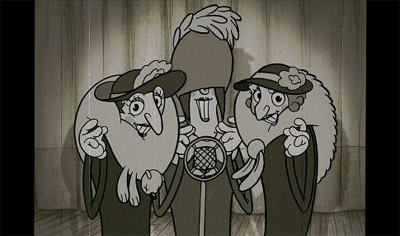
[camarades et amitié]
Matthieu Chedid -- Belleville Rendez-Vous (French Version)
Kraftwerk -- Tour de France (French Version)
A young boy grows up to become a cyclist whom the French mafia want to kidnap to use as a power source. Yes. This is a common problem.
A few points about the French mafia:
1. They are better-dressed than the American mafia.
2. They are less interested in practicality than in the je ne sais quoi of an idea.
3. They tend to be broad and squarish and so thin they nearly disappear when they turn to the side. For this reason, they could be lurking anywhere.
Childhood events exercise a curious power over the mind (whether human or canine). Yes. They are called "formative years" for a reason.
A few points about The Triplets of Belleville:
1. It's quirky (you guessed that).
2. It's visually innovative.
3. It has sparse dialogue.
Benoit Charest writes, and Matthieu Chedid sings,* warm organic music with real instruments. Kraftwerk makes cold computerized music with circuits and knobs and switches.
A few points about Belleville Rendez-Vous (French Version):
1. acoustic guitar, muted strums.
2. classical guitar with the fingers breakdancing down the frets.
3. the voice. the voices. the harmony.
A few points about Tour de France (French Version):
1. drum machines, bike chain, grunts of a cyclist up a long hill.
2. the guitar, sounding like steel drums, with an unlikely melody.
3. the harp suggesting that might be the warmest Kraftwerk get.
[Triplets of Belleville]
[I think the French version is the same as the Francois K. remix on this disc but I'm not sure, as I only have the LP EP.]
...
If you don't read Girish's site you probably missed the notice, and even if you do read it, you might have forgotten about it, but I'm calling for a horror film blogathon on October 31st. (And today is a bit late to make the announcement, yes; suffice it to say that organizing movements is not one of my strong points.)
The blogathon is an idea Girish cooked up: bloggers write about one topic and all post on the same day; all you have to do to be a part of it is to post on the topic and say you're a part of it. In the past people have written on Showgirls, avant-garde film, Abel Ferrara's films, Hayao Miyazaki's films, Michelle Pfeiffer's films, and Code Unknown. If you decide to take part, please send me the URL once you've posted so I can link to it.
Elsewhere:
Soulheads, don't miss Darcy's post on The Ohio Players, Dan Phillips' post on Bobby Rush, and Soul Sides' post on Johnny Otis.
...
The House Next Door with a Jonathan Rosenbaum interview.
...
Fast Film, an animated movie mashup short. I've seen this before, though I can't remember where.
...
For the sidefills, can we have two great big enormous things please, of a type that might be venerated as gods by the inhabitants of Easter Island, capable of reaching volumes that would make Beelzebub soil his underpants, and driven by amplifiers that could provide the power for a Monster Truck Rally.
Iggy Pop's concert rider
...
Free Hugs: much better with the sound off. I like it with Ernie K-Doe's "Te Ta Te Ta Ta."
...
one-dimensional Tetris.
*Thanks to Vincent for correcting me on the attribution.
Pédaler en grand braquet

[camarades et amitié]
Matthieu Chedid -- Belleville Rendez-Vous (French Version)
Kraftwerk -- Tour de France (French Version)
A young boy grows up to become a cyclist whom the French mafia want to kidnap to use as a power source. Yes. This is a common problem.
A few points about the French mafia:
1. They are better-dressed than the American mafia.
2. They are less interested in practicality than in the je ne sais quoi of an idea.
3. They tend to be broad and squarish and so thin they nearly disappear when they turn to the side. For this reason, they could be lurking anywhere.
Childhood events exercise a curious power over the mind (whether human or canine). Yes. They are called "formative years" for a reason.
A few points about The Triplets of Belleville:
1. It's quirky (you guessed that).
2. It's visually innovative.
3. It has sparse dialogue.
Benoit Charest writes, and Matthieu Chedid sings,* warm organic music with real instruments. Kraftwerk makes cold computerized music with circuits and knobs and switches.
A few points about Belleville Rendez-Vous (French Version):
1. acoustic guitar, muted strums.
2. classical guitar with the fingers breakdancing down the frets.
3. the voice. the voices. the harmony.
A few points about Tour de France (French Version):
1. drum machines, bike chain, grunts of a cyclist up a long hill.
2. the guitar, sounding like steel drums, with an unlikely melody.
3. the harp suggesting that might be the warmest Kraftwerk get.
[Triplets of Belleville]
[I think the French version is the same as the Francois K. remix on this disc but I'm not sure, as I only have the LP EP.]
...
If you don't read Girish's site you probably missed the notice, and even if you do read it, you might have forgotten about it, but I'm calling for a horror film blogathon on October 31st. (And today is a bit late to make the announcement, yes; suffice it to say that organizing movements is not one of my strong points.)
The blogathon is an idea Girish cooked up: bloggers write about one topic and all post on the same day; all you have to do to be a part of it is to post on the topic and say you're a part of it. In the past people have written on Showgirls, avant-garde film, Abel Ferrara's films, Hayao Miyazaki's films, Michelle Pfeiffer's films, and Code Unknown. If you decide to take part, please send me the URL once you've posted so I can link to it.
Elsewhere:
Soulheads, don't miss Darcy's post on The Ohio Players, Dan Phillips' post on Bobby Rush, and Soul Sides' post on Johnny Otis.
...
The House Next Door with a Jonathan Rosenbaum interview.
...
Fast Film, an animated movie mashup short. I've seen this before, though I can't remember where.
...
For the sidefills, can we have two great big enormous things please, of a type that might be venerated as gods by the inhabitants of Easter Island, capable of reaching volumes that would make Beelzebub soil his underpants, and driven by amplifiers that could provide the power for a Monster Truck Rally.
Iggy Pop's concert rider
...
Free Hugs: much better with the sound off. I like it with Ernie K-Doe's "Te Ta Te Ta Ta."
...
one-dimensional Tetris.
*Thanks to Vincent for correcting me on the attribution.
Labels: blogathon, electronica, soundtrack
Thursday, October 12, 2006:
Fanfare Pourpour -- La Vieille Valse du Dimanche Après-Midi
For some reason, listening to MTO reminded me of a strange band I heard a couple of years ago when I took my daughter bike-riding in Montreal. We went up to ride the Tour de l'Île de Montréal, a 48-km joyride taken by 30,000 bicyclists around the island city each June. She valiantly toughed out the long ride in the summer sun, finishing at a small park where there was a festival for the tired riders. We collapsed on the grass, popped open some water bottles, and started listening to an odd band playing on a nearby stage.
A stranger agglomeration of instruments I could scarcely imagine. Fifteen or so musicians with a couple of accordions, guitars, clarinets, trumpets, flutes, saxophones of various sizes, snaredrum, keyboard, stand-up bass, violins and the occasional banjo -- playing a chaotic, spirited, gypsy-like music that inspired children and adults to dance free-form before the stage.
"What do you call this," I asked one of the musicians during a break. "Fanfare" came the reply. That didn't help much. My own best effort to describe their music would be as a cross between circus and movie music, running largely to waltzes.
The band was announced as Fanfare Pourpour (pronounced "poo-poo"). I bought one of their CDs and brought it home. Nobody in my house understands why I like it so much. In fact, they don't even let me play it when they're around. I don't care. Whether it's the memory of my original enjoyment, its overall oddness, or even that it's actually pretty good, I'm not sure. Judge for yourself.
I'd like to know more about this unusual group. As best I can tell, it seems to be some kind of street music collective that's been playing together in one form or another for 30 years or so.
These are my two favorite songs on the album, Le Bal. The first is a haunting melody that sounds to my ears like a World War I-vintage antiwar song (although with my high school French, it could be something altogether different). I think the title translates as "Where has the happiness gone?" The second is described as "traditional Cajun"; the tune sounds vaguely familiar but transformed in their imagination into something unique and spontaneous.
[Le Bal]
The Roots Canal: Fanfare Pourpour
Fanfare Pourpour -- Le Temps du BonheurFanfare Pourpour -- La Vieille Valse du Dimanche Après-Midi
For some reason, listening to MTO reminded me of a strange band I heard a couple of years ago when I took my daughter bike-riding in Montreal. We went up to ride the Tour de l'Île de Montréal, a 48-km joyride taken by 30,000 bicyclists around the island city each June. She valiantly toughed out the long ride in the summer sun, finishing at a small park where there was a festival for the tired riders. We collapsed on the grass, popped open some water bottles, and started listening to an odd band playing on a nearby stage.
A stranger agglomeration of instruments I could scarcely imagine. Fifteen or so musicians with a couple of accordions, guitars, clarinets, trumpets, flutes, saxophones of various sizes, snaredrum, keyboard, stand-up bass, violins and the occasional banjo -- playing a chaotic, spirited, gypsy-like music that inspired children and adults to dance free-form before the stage.
"What do you call this," I asked one of the musicians during a break. "Fanfare" came the reply. That didn't help much. My own best effort to describe their music would be as a cross between circus and movie music, running largely to waltzes.
The band was announced as Fanfare Pourpour (pronounced "poo-poo"). I bought one of their CDs and brought it home. Nobody in my house understands why I like it so much. In fact, they don't even let me play it when they're around. I don't care. Whether it's the memory of my original enjoyment, its overall oddness, or even that it's actually pretty good, I'm not sure. Judge for yourself.
I'd like to know more about this unusual group. As best I can tell, it seems to be some kind of street music collective that's been playing together in one form or another for 30 years or so.
These are my two favorite songs on the album, Le Bal. The first is a haunting melody that sounds to my ears like a World War I-vintage antiwar song (although with my high school French, it could be something altogether different). I think the title translates as "Where has the happiness gone?" The second is described as "traditional Cajun"; the tune sounds vaguely familiar but transformed in their imagination into something unique and spontaneous.
[Le Bal]
Monday, October 09, 2006:
In last week's post on Johnny Otis, I wrote that he got his start in the "territorial orchestras" of the 1930s. Of course, to write that, I first had to look up what a territorial orchestra was. Then, this morning, I was listening to the news on NPR when they did a piece on a band called Millenial Territory Orchestra, or MTO. Naturally enough, I turned up the volume and listened in.
As Steven Bernstein explains on the NPR segment, territorial (or territory) orchestras were regional dance bands that wandered the country before big bands and kept alive a more raucous style of jazz than you'd hear on the radio at the time. The best definition I found on the Internet is by saxophonist Hal Singer, who also got his start in that era:
Here's a killer cut, a 9-minute version of Signed, Sealed, Delivered. Imagine a 21st-century Count Basie rising from the grave and reinterpreting Stevie Wonder. If that intrigues you, give this a listen. But go on and play the whole album; each track is completely different. Others are more "jazz-like" than this one. There's nothing typical on this record.
Update (bonus track): On second thought, I'm not sure the Stevie Wonder song gives the full flavor of how MTO has updated the territorial orchestra idea. So here's another track from the album, a raucous instrumental, also long but definitely worth the seven minutes of your time.
MTO -- Darling Nikki
[MTO, Vol. 1] Also on emusic.
The Roots Canal: Millenial Territory Orchestra
MTO -- Signed, Sealed, DeliveredIn last week's post on Johnny Otis, I wrote that he got his start in the "territorial orchestras" of the 1930s. Of course, to write that, I first had to look up what a territorial orchestra was. Then, this morning, I was listening to the news on NPR when they did a piece on a band called Millenial Territory Orchestra, or MTO. Naturally enough, I turned up the volume and listened in.
As Steven Bernstein explains on the NPR segment, territorial (or territory) orchestras were regional dance bands that wandered the country before big bands and kept alive a more raucous style of jazz than you'd hear on the radio at the time. The best definition I found on the Internet is by saxophonist Hal Singer, who also got his start in that era:
I played in what we called a "territorial band," which was just the best jazz band in whatever region you lived in in America at that time.MTO is Bernstein's latest effort (after Spanish Fly and Sex Mob) to bring back the original sense of fun in jazz without making it any less challenging or ambitious. It's not an exercise in nostalgia. It's a unique combination of old and new, capturing the spirit of an earlier time but updating it for modern ears. I immediately downloaded MTO - Volume I from emusic, and loved it. I think you will, too.
Here's a killer cut, a 9-minute version of Signed, Sealed, Delivered. Imagine a 21st-century Count Basie rising from the grave and reinterpreting Stevie Wonder. If that intrigues you, give this a listen. But go on and play the whole album; each track is completely different. Others are more "jazz-like" than this one. There's nothing typical on this record.
Update (bonus track): On second thought, I'm not sure the Stevie Wonder song gives the full flavor of how MTO has updated the territorial orchestra idea. So here's another track from the album, a raucous instrumental, also long but definitely worth the seven minutes of your time.
MTO -- Darling Nikki
[MTO, Vol. 1] Also on emusic.
Wednesday, October 04, 2006:
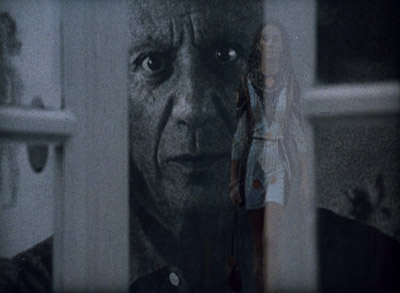
[Pablo Picasso and a girl who never called him an asshole.]
The Modern Lovers -- Pablo Picasso
Jonathan Richman & The Modern Lovers -- The Bank Teller
Jonathan Richman & The Modern Lovers -- Affection
I looked for Orson Welles' F for Fake for about five years before finding it. Gainesville is a smallish place, and Criterion did the world a service re-releasing the film last year. The film is a documentary about an art forger and his biographer, who himself begins forging documents. The film has stuck with me, not just because of the surprise ending but also because of the basic questions of expertise, reliability, trust, and sincerity. It's thoughtful and thought-provoking work, presented accessibly--yet its method is avant-garde (thanks for pointing that out, Girish!)--and it's only now occurring to me how much my last post owes to it.
Jonathan Richman & the Modern Lovers is not the same band as The Modern Lovers, though they do have the same Jonathan Richman. The Modern Lovers were a rock&roll/punk band and lasted from late 1970 to late 1973; after they broke up, Jonathan Richman continued recording with a different band under the same name.
Lyrically, Richman is a goofy geeky fellow with the occasional spark of nastiness. "Pablo Picasso" probably serves as a good example:
Well the girls would turn the color of avocado
When he would drive down their street in his El Dorado
Funny, right--cheesy? Then:
He could walk down your street
And girls could not resist his stare
Pablo Picasso never got called an asshole
Not like you
Is this a commiserating "Not like you"? No; the delivery makes that clear; it appends a mental "you asshole." It still doesn't fill out the meter, but meter isn't Richman's forte anyway.
"The New Teller" is an ode to the new bank teller, with handclaps, a rockin' country solo, and more cheesy rhymes ("teller" and "tell her", "There's only three in the other line / but in mine I count eleven / well, that's fine 'cause I'm in Heaven").
And then "Affection" is a simple, somber look back at Richman's earlier days, pointing out that being a snob makes you unhappy and that people need to risk pain for love. You could fault Richman for his sincerity and cheesiness, and plenty of people do, but I'm not one of them....
I posted The Modern Lovers last year as part of the jogging mix, but I find that the longer I post the less I'm concerned about if I've posted someone before. I doubt that that is Sturgeon's Law coming into play; if anything it's more a reflection of how much awesome music I still haven't heard.
[The Modern Lovers]
[Back in Your Life]
[Jonathan Richman & the Modern Lovers]
...
"It was a hot day when the horse came in and I was shocked at first because I have never run a pub before."
...
Sock puppets invade LJ. I was eager to see The Science of Sleep, but the studio falling back on sockpuppetry, astroturfing, and asshattery to promote it tells me that it's maybe not so very good after all.... Or maybe they just don't know how to market it (though God knows why that would be the case, with Michel Gondry, Gael García Bernal, and an arthouse theme).
...
Tone Memory, from which I deduce that I do not have perfect pitch, or possibly even any pitch at all.
Jonathan Richman & The Modern Lovers

[Pablo Picasso and a girl who never called him an asshole.]
The Modern Lovers -- Pablo Picasso
Jonathan Richman & The Modern Lovers -- The Bank Teller
Jonathan Richman & The Modern Lovers -- Affection
I looked for Orson Welles' F for Fake for about five years before finding it. Gainesville is a smallish place, and Criterion did the world a service re-releasing the film last year. The film is a documentary about an art forger and his biographer, who himself begins forging documents. The film has stuck with me, not just because of the surprise ending but also because of the basic questions of expertise, reliability, trust, and sincerity. It's thoughtful and thought-provoking work, presented accessibly--yet its method is avant-garde (thanks for pointing that out, Girish!)--and it's only now occurring to me how much my last post owes to it.
Jonathan Richman & the Modern Lovers is not the same band as The Modern Lovers, though they do have the same Jonathan Richman. The Modern Lovers were a rock&roll/punk band and lasted from late 1970 to late 1973; after they broke up, Jonathan Richman continued recording with a different band under the same name.
Lyrically, Richman is a goofy geeky fellow with the occasional spark of nastiness. "Pablo Picasso" probably serves as a good example:
Well the girls would turn the color of avocado
When he would drive down their street in his El Dorado
Funny, right--cheesy? Then:
He could walk down your street
And girls could not resist his stare
Pablo Picasso never got called an asshole
Not like you
Is this a commiserating "Not like you"? No; the delivery makes that clear; it appends a mental "you asshole." It still doesn't fill out the meter, but meter isn't Richman's forte anyway.
"The New Teller" is an ode to the new bank teller, with handclaps, a rockin' country solo, and more cheesy rhymes ("teller" and "tell her", "There's only three in the other line / but in mine I count eleven / well, that's fine 'cause I'm in Heaven").
And then "Affection" is a simple, somber look back at Richman's earlier days, pointing out that being a snob makes you unhappy and that people need to risk pain for love. You could fault Richman for his sincerity and cheesiness, and plenty of people do, but I'm not one of them....
I posted The Modern Lovers last year as part of the jogging mix, but I find that the longer I post the less I'm concerned about if I've posted someone before. I doubt that that is Sturgeon's Law coming into play; if anything it's more a reflection of how much awesome music I still haven't heard.
[The Modern Lovers]
[Back in Your Life]
[Jonathan Richman & the Modern Lovers]
...
"It was a hot day when the horse came in and I was shocked at first because I have never run a pub before."
...
Sock puppets invade LJ. I was eager to see The Science of Sleep, but the studio falling back on sockpuppetry, astroturfing, and asshattery to promote it tells me that it's maybe not so very good after all.... Or maybe they just don't know how to market it (though God knows why that would be the case, with Michel Gondry, Gael García Bernal, and an arthouse theme).
...
Tone Memory, from which I deduce that I do not have perfect pitch, or possibly even any pitch at all.
Monday, October 02, 2006:
Did you like that Shuggie Otis track? Try going back a generation. Shuggie's father Johnny Otis was one of the most remarkable figures in the history of R&B and rock'n'roll. You could describe him as the first white R&B star, but that wouldn't be quite right because Johnny Otis was white in skin tone only. Raised as Yannis Veliotes in Oakland, he basically decided he'd rather be black than Greek. He immersed himself in African-American music and culture, changed his name to Johnny Otis and has pretty much lived as a black man in the black community for the last 70 years.
Johnny Otis lived more lives than most of us get to dream of. He started as a jazz drummer with "territorial bands" in the late '30s and early '40s. He was a session man on such landmark recordings as Illinois Jacquet's Flyin' Home (the song that kicked off the screaming saxophone rage) and Charles Brown's Driftin' Blues. He had his own band by 1945 and his first hit with Harlem Nocturne. But he gravitated to the new rhythm and blues scene and opened the first R&B-only club, The Barrelhouse, in 1948. The club became the center of the LA R&B scene, where Johnny discovered and showcased stars like Little Esther, Etta James and Big Mama Thornton. He toured the country repeatedly with The Johnny Otis R&B Caravan. He arranged and played drums on the original Hound Dog. He started a couple of record labels. He hosted several popular R&B radio and TV shows. In the late '50s, he became a rock'n'roll star himself with Willie and the Hand Jive. By the 1960s, R&B was out of favor and Johnny turned to other endeavors with the same boundless energy. He started a chicken farm. He painted and sculpted. He got involved in politics and became Deputy Chief of Staff to a congressman. He wrote a couple of books about black music, culture and politics. He launched an R&B revival. He helped his son start his own career. He was ordained as a minister. He started a natural foods store. He still runs his own website.
Johnny's heyday was in the early 1950s. In 1950 alone, he had ten songs in Billboard's Top Ten, including three at #1 featuring Little Esther. I particularly like All Night Long, a wild early rocker featuring Mel Walker, released in 1951. You can still hear them hand-clapping on the back beat, just like Wynonie Harris' Good Rockin' Tonight.
Want to hear more? There are a zillion Johnny Otis albums out there, like The Original Johnny Otis Show and The Greatest Johnny Otis Show. For a quick introduction, try The Essential Recordings on emusic. There are also a couple of boxed sets that capture the whole era: Midnight at the Barrelhouse on emusic or The Johnny Otis R&B Caravan at Amazon. You can check out his raunchier side on Snatch & the Poontangs. Unfortunately, his 1970 R&B revival album, The Johnny Otis Show Live at Monterey, featuring comeback performances by Roy Brown, Big Joe Turner and Roy Milton along with Shuggie on lead guitar, is out of print but 14 of the 19 cuts are on iTunes.
Want to learn more? Check out this three-part bio on JammUpp, the bio on Johnny's own site, or these bios at allmusic and Wikipedia.
Bonus track: Here's a great novelty song from 1950, Wedding Boogie. It was released under the name The Johnny Otis Congregation. Little Esther plays the bride, Mel Walker the groom and Lee Graves is the preacher. Have some fun!
The Johnny Otis Congregation -- Wedding Boogie
The Roots Canal: Johnny Otis
Johnny Otis with Mel Walker -- All Night LongDid you like that Shuggie Otis track? Try going back a generation. Shuggie's father Johnny Otis was one of the most remarkable figures in the history of R&B and rock'n'roll. You could describe him as the first white R&B star, but that wouldn't be quite right because Johnny Otis was white in skin tone only. Raised as Yannis Veliotes in Oakland, he basically decided he'd rather be black than Greek. He immersed himself in African-American music and culture, changed his name to Johnny Otis and has pretty much lived as a black man in the black community for the last 70 years.
Johnny Otis lived more lives than most of us get to dream of. He started as a jazz drummer with "territorial bands" in the late '30s and early '40s. He was a session man on such landmark recordings as Illinois Jacquet's Flyin' Home (the song that kicked off the screaming saxophone rage) and Charles Brown's Driftin' Blues. He had his own band by 1945 and his first hit with Harlem Nocturne. But he gravitated to the new rhythm and blues scene and opened the first R&B-only club, The Barrelhouse, in 1948. The club became the center of the LA R&B scene, where Johnny discovered and showcased stars like Little Esther, Etta James and Big Mama Thornton. He toured the country repeatedly with The Johnny Otis R&B Caravan. He arranged and played drums on the original Hound Dog. He started a couple of record labels. He hosted several popular R&B radio and TV shows. In the late '50s, he became a rock'n'roll star himself with Willie and the Hand Jive. By the 1960s, R&B was out of favor and Johnny turned to other endeavors with the same boundless energy. He started a chicken farm. He painted and sculpted. He got involved in politics and became Deputy Chief of Staff to a congressman. He wrote a couple of books about black music, culture and politics. He launched an R&B revival. He helped his son start his own career. He was ordained as a minister. He started a natural foods store. He still runs his own website.
Johnny's heyday was in the early 1950s. In 1950 alone, he had ten songs in Billboard's Top Ten, including three at #1 featuring Little Esther. I particularly like All Night Long, a wild early rocker featuring Mel Walker, released in 1951. You can still hear them hand-clapping on the back beat, just like Wynonie Harris' Good Rockin' Tonight.
Want to hear more? There are a zillion Johnny Otis albums out there, like The Original Johnny Otis Show and The Greatest Johnny Otis Show. For a quick introduction, try The Essential Recordings on emusic. There are also a couple of boxed sets that capture the whole era: Midnight at the Barrelhouse on emusic or The Johnny Otis R&B Caravan at Amazon. You can check out his raunchier side on Snatch & the Poontangs. Unfortunately, his 1970 R&B revival album, The Johnny Otis Show Live at Monterey, featuring comeback performances by Roy Brown, Big Joe Turner and Roy Milton along with Shuggie on lead guitar, is out of print but 14 of the 19 cuts are on iTunes.
Want to learn more? Check out this three-part bio on JammUpp, the bio on Johnny's own site, or these bios at allmusic and Wikipedia.
Bonus track: Here's a great novelty song from 1950, Wedding Boogie. It was released under the name The Johnny Otis Congregation. Little Esther plays the bride, Mel Walker the groom and Lee Graves is the preacher. Have some fun!
The Johnny Otis Congregation -- Wedding Boogie

